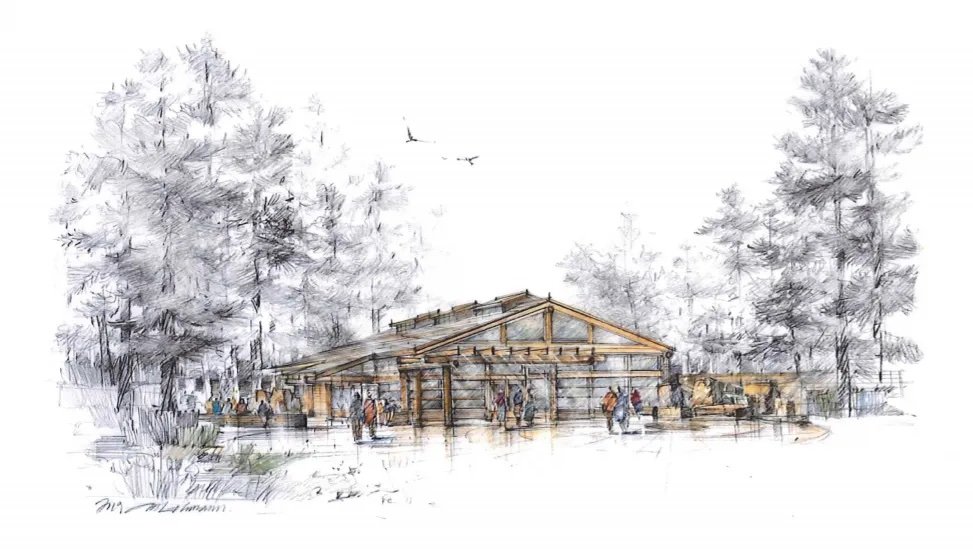Western’s Longhouse
By Aryonna Willoughby
June 12, 2020
A rendering of the longhouse that has been proposed for Western Washington University’s campus in Bellingham, Wash. // Western Washington University.
“I would like to begin by acknowledging that we gather today on the ancestral homelands of the Coast Salish Peoples… Please join me in expressing our deepest respect and gratitude for our indigenous neighbors, the Lummi Nation and Nooksack Tribe, for their enduring care and protection of our shared lands and waterways.”
This statement might be familiar to students of Western Washington University. It is often stated at the beginning of university events. Laural Ballew, Western’s executive director of tribal relations believes the statement is really just words.
As of 2018, graduation and retention rates of Native American students at WWU were lower than almost any other ethnic group. Ballew and members of Western’s Native American Student Union (NASU) believe the construction of a Coast Salish longhouse would be a concrete step the university could take to support their words.
“This project is going to really put action behind those words [of the land acknowledgment statement] and show that we really do support our Native students,” Ballew said.
IGNITION
The call for action began in 2016 with a letter written by former NASU Tribal Councilmembers Michaela Vendiola, Tahlia Natachu and Kylie Gemmell. Addressed to then-Western President Bruce Shepard and faculty, the letter outlined five requests for the university to prioritize in their strategic plan to help support Native American students.
Building a traditional Coast Salish longhouse was one of the requests.
Ballew carries a copy of the letter with her at all times, keeping it in her planner. The first request in the letter was for Western to create a university position dedicated to the success of Native American students, something many other universities along the Pacific coast had already done. In early 2019, the university hired Ballew as the executive director of American Indian/Alaska Native and First Nations relations and tribal liaison to the president.
The second request was building a longhouse. Historically, longhouses were seasonal homes for the Coast Salish people, where several families often lived together. The families slept, prepared food and fires and held cultural activities in the structures. Longhouses are now treated more as heritage centers where cultural events and ceremonies are held. The University of Washington, Oregon State University and other Pacific Northwest universities have built longhouse structures for their Native American students.
Proponents of Western’s longhouse say it will support the university’s Native American students by providing a space to gather, hold ceremonial events and promote cultural understanding. The proposed plans for the longhouse include a gathering hall, indoor and outdoor kitchens and student lounges. Ballew also hopes for the structure to include a classroom and offices where support and resources would be offered to Native American students.
Although the proposed building wouldn’t be a Coast Salish longhouse by the traditional definition, Ballew said the concept of what those structures represent would be reflected in the university’s project.
“The goal is to have a space on campus representative of the Coast Salish people, where our Native students can come and gather, hold their traditional ceremonies, or just have a place,” Ballew said.
The need for a place is familiar to some students. Aurora Martinez graduated from Western in 2018 with a degree in kinesiology. As a Native American alumnus, Martinez recognizes Native American students at Western do not have the same opportunities for cultural expression as Native American students at other universities.
“I wish there was a longhouse because I often felt like I needed a place to sing or dance and found myself going under by where the music majors practice to get away and find this spiritual connection,” Martinez said.
Martinez said she believes a longhouse at Western would be amazing because not only would it support Native American students, but it would provide people the opportunity to learn about Native American culture that is so prominent to the university. As well as having Native American students as a part of the campus community, Western’s campus sits directly on the homeland of the Coast Salish people.
NUMBERS DON’T LIE
Ballew and others believe the presence of a longhouse at Western will help increase the recruitment of Native American students and improve their retention and graduation rates.
Nationally, about half of Native American students who enroll in major colleges and universities continue into their second year, compared to almost 70% of the general population, according to a 2013 study in the American Indian Culture and Research Journal.
At Western, the retention rate of first-year Native American students was the second-lowest among all ethnic groups at 70.9% in 2018 while the retention rate of their first-year white counterparts was 83.2%.
To help Native American students succeed, The University of Washington constructed a longhouse-style facility called wǝɫǝbʔaltxʷ, meaning “Intellectual House” in the Lushootseed language, on their Seattle campus in 2015.
University of Washington’s longhouse wǝɫǝbʔaltxʷ juxtaposed over Western Washington University’s campus. UW is one of the many colleges in the Pacific Northwest that has built longhouses to support indigenous students. //Kassidy Haluska.
Since the building’s opening, the University of Washington has witnessed a general increase in the rate of Native American students returning after their first year of college and graduating, said Michael Yates, the administrative assistant at wǝɫǝbʔaltxʷ. In 2017, the percentage of Native American students graduating from the University of Washington within six years rose to 77.3%, an increase of 7% from 2016.
While Yates would like to attribute the increase solely to the construction of the longhouse and the support it provides to Native American students, he acknowledges the university has worked on multiple fronts to diversify the campus.
“We’ve been trying to monitor those [rates]. It’s only been five years. We don’t have a whole ton of data on it, but what we’ve noticed is a steady increase,” Yates said.
Although it was fully open and functional before the pandemic prompted closures across the university, wǝɫǝbʔaltxʷ is only halfway finished.
“When we started putting the money to work, the recession hit, and the quote that we got back was actually much higher than we expected,” Yates said.
Realizing that there wasn’t enough initial funding, the university decided to break the construction of the longhouse into two phases. The first phase, which is now complete, was focused on establishing a community gathering space. The plans for phase two, which hasn’t been completed yet, are much more student-focused, Yates said.
Phase two will focus on creating designated meeting rooms, bringing an elder to campus to offer advice and guidance to students, and building a native art lab where students will be able to create carvings, pottery, copper work and other artwork, Yates said. The university is currently in the fundraising process, but Yates isn’t quite sure when the second phase will be completed.
“We’ve kind of got a hopeful feeling from a couple of fundraising opportunities and donors that we’ve contacted. We feel like it’ll probably be about five years,” Yates said. “But who knows? With COVID-19 it might push everything back another five.”
MAKING A DREAM REALITY
Before Western can move forward with building a longhouse of their own, the school needs to find funding. The full cost of the project has yet to be determined, said Paul Cocke, Western’s communications and marketing director.
In February, NASU representatives Sienna Reid, Grey Webster and Deviney Wynecoop, along with Ballew and the club’s advisor Kristen French, traveled to Olympia to urge state lawmakers to support funding for the longhouse. Although funding was not secured from the state, Western President Sabah Randhawa and many others are strongly supportive of the proposed longhouse, said Cocke in an email. It’s unclear what level of funding was sought from lawmakers.
Getting Western’s capital budget requests to the state is a lengthy process that requires the collaboration of Western’s University Planning and Resources Council and Western’s Board of Trustees, according to Cocke.
“This likely will be a challenging budget session in the Legislature due to the coronavirus pandemic and the devastating effect on the state economy,” Cocke said in an email. “However, Western will continue to advocate for its capital budget requests, including the longhouse.”
Among the supporters for Western’s proposed longhouse is State Rep. Debra Lekanoff. Lekanoff, a Native American legislator for the 40th district, is personally involved with the project and has even proposed “calling the longhouse the ‘House of Healing’ as part of the pandemic recovery efforts,” Cocke said.
“The Coast Salish people have long understood the importance of collective healing in response to shared historical trauma, as well as holding the power of traditional and cultural practices in order to overcome hardship,” Lekanoff wrote in a newsletter. “By acknowledging the past trauma and suffering of Indigenous people and all ethnic groups, the dedication of providing a place of healing and support will benefit the recovery process.”
Ballew is currently working from home under a veil of uncertainty. She doesn’t yet have a timeline for the completion of the longhouse and no one quite knows what the future will hold following the fallout from COVID-19. Nevertheless, she works on composing grant proposals and analyzing the budgets. She also plans to form a tribal inclusive advisory committee, recruited from NASU members, tribal leaders and representatives, to offer help and advice on the design of the longhouse.
“I’ve got the dream and I’ve got the go-ahead for the dream. Now, I just gotta make it happen,” said Ballew.


